Industry News, trenchless projects
Galerie des Janots Main Beam completes Arduous French Drive
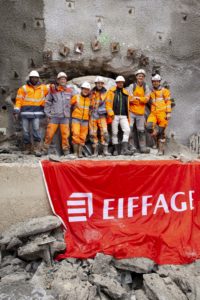 In April 2019, a Robbins 3.5 m (11.5 ft) diameter Main Beam TBM broke through into open space, completing its 2.8 km (1.7 mi) long tunnel. It was not the first time the machine had encountered open space: twice during tunneling, the machine hit uncharted caverns, the largest of which measured a staggering 8,000 cubic meters (283,000 cubic ft) in size.
In April 2019, a Robbins 3.5 m (11.5 ft) diameter Main Beam TBM broke through into open space, completing its 2.8 km (1.7 mi) long tunnel. It was not the first time the machine had encountered open space: twice during tunneling, the machine hit uncharted caverns, the largest of which measured a staggering 8,000 cubic meters (283,000 cubic ft) in size.
The obstacles overcome at the recent breakthrough are a significant achievement, said Marc Dhiersat, Project Director of the Galerie des Janots tunnel for contractor Eiffage Civil Construction. “We are proud to have led a motivated and conscientious team to the end of the tunnel who worked well without accidents despite the many technical difficulties encountered.”
The water tunnel, located below the community of Cassis, France, is an area of limestone known for its groundwater, karstic cavities, and voids. The limestone, combined with powdery clays, made for difficult excavation after the machine’s March 2017 launch. At the 1,035 m (3,395 ft) mark, the crew hit a cavern on the TBM’s left side. The cavern, studded with stalactites and stalagmites, was grazed by the TBM shield. The crew had to erect a 4 m (13 ft) high wall of concrete so the TBM would have something to grip against. The TBM was then started up and was able to successfully navigate out of the cavern in eight strokes without significant downtime to the operation—the process took about two weeks. Despite the challenges, Dhiersat thought positively of the TBM throughout the ordeal: “This has been the best machine for the job due to all the geological difficulties.”
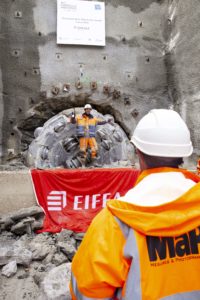 The first cavern, while the largest, was not the most difficult void encountered. The machine was averaging 20 to 22 m (65 to 72 ft) advance per day in two shifts after clearing the first cavity, with a dedicated night shift for maintenance. While excavating, a combination of probe drilling and geotechnical BEAM investigation—a type of electricity-induced polarization to detect anomalies ahead of the TBM—were used. Crews ran the excavation five days per week, achieving over 400 m (1,310 ft) in one month. This performance continued until the 2,157 m (7,077 ft) mark, when the machine grazed the top of an unknown cavity that extended deep below the tunnel path. The structure measured 22 m (72 ft) long, 15 m (49 ft) wide, and 14 m (46 ft) deep, or about 4,500 cubic meters (159,000 cubic ft) of open space.
The first cavern, while the largest, was not the most difficult void encountered. The machine was averaging 20 to 22 m (65 to 72 ft) advance per day in two shifts after clearing the first cavity, with a dedicated night shift for maintenance. While excavating, a combination of probe drilling and geotechnical BEAM investigation—a type of electricity-induced polarization to detect anomalies ahead of the TBM—were used. Crews ran the excavation five days per week, achieving over 400 m (1,310 ft) in one month. This performance continued until the 2,157 m (7,077 ft) mark, when the machine grazed the top of an unknown cavity that extended deep below the tunnel path. The structure measured 22 m (72 ft) long, 15 m (49 ft) wide, and 14 m (46 ft) deep, or about 4,500 cubic meters (159,000 cubic ft) of open space.
Crews probed in front of the cutterhead and began work to stabilize and secure the cavity with foam and concrete, as well as excavate a bypass gallery. “After filling much of the cavity (1,500 m3/53,000 ft3), our biggest difficulty was to ensure the gripping of the machine: We needed six bypass galleries and four months of work to reach the end of this challenge,” said Dhiersat. For the last 600 m (2,000 ft) of tunneling, “we were finally in good rock,” he emphasized. Overall rates for the project averaged 18 m (59 ft) per day in two shifts, and topped out at 25 m (82 ft) in one day.
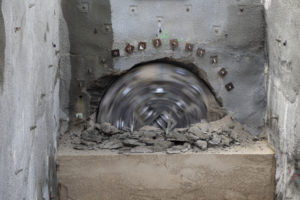 “The cooperation with Marc and his team on site was very good and we always enjoyed their professionalism and commitment to the project and the task. This, without any doubt was key for the success we achieved,” said Detlef Jordan, Business Manager Robbins Europe. “For us, it was satisfying and motivating to see that, by working together and joining the efforts of all partners on the project, the best and most successful outcome can be achieved. This commitment for decades has been at the heart of success in the tunneling industry, but it has not always been observed on other recent projects.”
“The cooperation with Marc and his team on site was very good and we always enjoyed their professionalism and commitment to the project and the task. This, without any doubt was key for the success we achieved,” said Detlef Jordan, Business Manager Robbins Europe. “For us, it was satisfying and motivating to see that, by working together and joining the efforts of all partners on the project, the best and most successful outcome can be achieved. This commitment for decades has been at the heart of success in the tunneling industry, but it has not always been observed on other recent projects.”
 Galerie des Janots is one of fourteen operations designed to save water and protect resources, which are being carried out by the Aix-Marseille-Provence metropolis, the water agency Rhône Mediterranean Corsica, and the State Government. The Janots gallery, once online, will replace existing pipelines currently located in a railway tunnel—these original pipes have significant deficiencies with estimated water losses of 500,000 cubic meters (132 million gallons) per year. The new tunnel will increase capacity to 440 liters (116 gallons) per second.
Galerie des Janots is one of fourteen operations designed to save water and protect resources, which are being carried out by the Aix-Marseille-Provence metropolis, the water agency Rhône Mediterranean Corsica, and the State Government. The Janots gallery, once online, will replace existing pipelines currently located in a railway tunnel—these original pipes have significant deficiencies with estimated water losses of 500,000 cubic meters (132 million gallons) per year. The new tunnel will increase capacity to 440 liters (116 gallons) per second.
Image 1: Contractor Eiffage Civil Construction celebrates the April 2019 breakthrough of a 3.5 m (11.5 ft) diameter Robbins Main Beam TBM in Cassis, France.
Image 2: Despite challenges including karstic limestone and clay, the Robbins TBM at Galerie des Janots achieved rates of 18 m (59 ft) per day on average, and topped out at 25 m (82 ft) in one day.
Image 3: The Robbins machine overcame tough conditions including two uncharted caverns, the largest of which measured a staggering 8,000 cubic meters (283,000 cubic ft) in size.
Image 4: The first cavern, encountered at the 1,035 m (3,395 ft) mark, was grazed by the TBM shield on one side and was studded with stalactites and stalagmites.
Industry News, trenchless projects
XRE Machine completed National Priority Water Line set to go Live in March
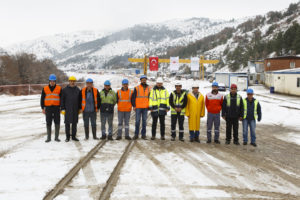 Excavation of Turkey’s longest water tunnel came to an end on December 18, 2018. To get there, a 5.56 m (18.2 ft) diameter Robbins Crossover (XRE) TBM and the contractor JV of Kolin/Limak had to overcome dozens of major fault zones and water pressures up to 26 bar. The completed national priority water line is set to go into operation in March 2019.
Excavation of Turkey’s longest water tunnel came to an end on December 18, 2018. To get there, a 5.56 m (18.2 ft) diameter Robbins Crossover (XRE) TBM and the contractor JV of Kolin/Limak had to overcome dozens of major fault zones and water pressures up to 26 bar. The completed national priority water line is set to go into operation in March 2019.
The 31.6 km (19.6 mi) long Gerede Water Transmission Tunnel is an urgently needed project due to severe and chronic droughts in the capital city Ankara. Its final leg, a 9.0 km (5.6 mi) section of extremely difficult ground including sandstone agglomerate, limestone and tuff, was just one section in the middle of a tunnel widely considered to be the most challenging ever driven by TBMs in Turkey. “I’ve had the chance to study and visit the majority of mechanized tunnelling projects in Turkey since the 1980s. The Gerede project is one of the most challenging projects among them,” said Dr. Nuh Bilgin, Professor of Mine and Tunnel Mechanization at Istanbul Technical University and Chairman of the Turkish Tunnelling Society.
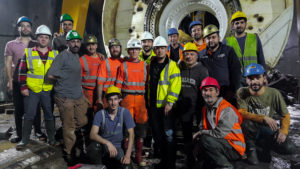 The Robbins XRE TBM was called in to complete the tunnel, which was at a standstill after using three Double Shield TBMs from another manufacturer. Those machines encountered incredibly difficult geology including massive inrushes of mud and water. The Kolin/Limak JV had to develop a new strategy given the unexpected ground conditions. They contacted The Robbins Company, who suggested a Crossover (Dual-Mode Type) TBM for the remaining section of tunnel. “The Crossover TBM provided great ease and versatility during the entire project with frequently changing ground conditions. The TBM was equipped with features such as increased thrust, two-speed gearbox, and modular screw conveyor. It was capable of giving the necessary responses in different geologies, which was our most important asset in achieving our goal,” said Barış Duman, Project Manager for the Kolin – Limak JV.
The Robbins XRE TBM was called in to complete the tunnel, which was at a standstill after using three Double Shield TBMs from another manufacturer. Those machines encountered incredibly difficult geology including massive inrushes of mud and water. The Kolin/Limak JV had to develop a new strategy given the unexpected ground conditions. They contacted The Robbins Company, who suggested a Crossover (Dual-Mode Type) TBM for the remaining section of tunnel. “The Crossover TBM provided great ease and versatility during the entire project with frequently changing ground conditions. The TBM was equipped with features such as increased thrust, two-speed gearbox, and modular screw conveyor. It was capable of giving the necessary responses in different geologies, which was our most important asset in achieving our goal,” said Barış Duman, Project Manager for the Kolin – Limak JV.
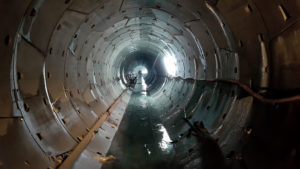 “The challenging part for us was to design and manufacture a TBM that could complete the difficult section of the Gerede Tunnel where two other competitor TBMs had failed,” said Yunus Alpagut, Robbins representative in Turkey. The specialized machine was designed to statically hold water pressure up to 20 bar, a failsafe that none of the standard Double Shield TBMs had been equipped with. A convertible cutterhead was also provided that was designed for ease of conversion between hard rock and EPB modes, and with cutter housings that could be fitted with either disc cutters or tungsten carbide tooling. To cope with difficult ground, the Gerede machine was also equipped with the Torque-Shift System, multi-speed gearing allowing the machine to function as either an EPB or a hard rock TBM. This function is done by adding another gear reduction–heavy duty pinions and bull gears accommodate high torque at low speed, allowing the machine to bore through fault zones and soft ground without becoming stuck.
“The challenging part for us was to design and manufacture a TBM that could complete the difficult section of the Gerede Tunnel where two other competitor TBMs had failed,” said Yunus Alpagut, Robbins representative in Turkey. The specialized machine was designed to statically hold water pressure up to 20 bar, a failsafe that none of the standard Double Shield TBMs had been equipped with. A convertible cutterhead was also provided that was designed for ease of conversion between hard rock and EPB modes, and with cutter housings that could be fitted with either disc cutters or tungsten carbide tooling. To cope with difficult ground, the Gerede machine was also equipped with the Torque-Shift System, multi-speed gearing allowing the machine to function as either an EPB or a hard rock TBM. This function is done by adding another gear reduction–heavy duty pinions and bull gears accommodate high torque at low speed, allowing the machine to bore through fault zones and soft ground without becoming stuck.
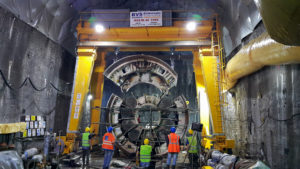 The Crossover machine was assembled in spring 2016 after crews excavated a bypass tunnel to one side of one of the stuck Double Shield TBMs. An underground assembly chamber allowed the machine to be built in the tunnel using Onsite First Time Assembly (OFTA). “The logistics of getting components through the existing tunnel were the most challenging thing. The assembly chamber was 7 km (4 mi) from the portal. The water inflow of 600 l/s (159 gal/s) made it difficult to get the materials to the machine,” said Glen Maynard, Robbins Field Service Site Manager.
The Crossover machine was assembled in spring 2016 after crews excavated a bypass tunnel to one side of one of the stuck Double Shield TBMs. An underground assembly chamber allowed the machine to be built in the tunnel using Onsite First Time Assembly (OFTA). “The logistics of getting components through the existing tunnel were the most challenging thing. The assembly chamber was 7 km (4 mi) from the portal. The water inflow of 600 l/s (159 gal/s) made it difficult to get the materials to the machine,” said Glen Maynard, Robbins Field Service Site Manager.
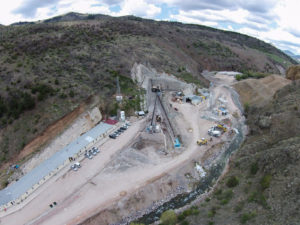 Despite the challenges, the machine began boring in summer 2016 and within the first 50 m (160 ft) of boring had successfully passed through the section that buried the original Double Shield TBM. The machine was required to be used in EPB mode as it encountered water pressures up to 26 bars, alluvium, flowing materials, clay and a total of 48 fault zones. Water pressure was lowered by draining the ground water through the rear shield probe drill ports, which were equipped with normally-closed ball valves. Probe drilling was done on a routine basis to get through the ground conditions. “Together with the difficult geological conditions the travel time to reach the TBM within the tunnel had effects on TBM performance. Despite this constraint, the tunnel excavation achieved a best day of 29.4 m (96.5 ft), best week of 134.6 m (441.6 ft) and a best month of 484 m (1,588 ft),” said Duman.
Despite the challenges, the machine began boring in summer 2016 and within the first 50 m (160 ft) of boring had successfully passed through the section that buried the original Double Shield TBM. The machine was required to be used in EPB mode as it encountered water pressures up to 26 bars, alluvium, flowing materials, clay and a total of 48 fault zones. Water pressure was lowered by draining the ground water through the rear shield probe drill ports, which were equipped with normally-closed ball valves. Probe drilling was done on a routine basis to get through the ground conditions. “Together with the difficult geological conditions the travel time to reach the TBM within the tunnel had effects on TBM performance. Despite this constraint, the tunnel excavation achieved a best day of 29.4 m (96.5 ft), best week of 134.6 m (441.6 ft) and a best month of 484 m (1,588 ft),” said Duman.
“We had many challenging areas with water and high pressures up to 26 bar along with alluvial material in fault zones. Ground pressure on the shield body caused squeezing conditions in clay. In these regions, we were able to quickly pass through by keeping the TBM advance rate, cutterhead rpm and screw conveyor rotation speed at the ideal level. Ultimately, we think our decision to select a Crossover TBM was correct,” continued Duman.
With tunneling complete, the pipeline is on track to open in March 2019. The tunnel will convey water from the Gerede River to Çamlıdere Dam, which provides potable water for the Ankara city water system.
Image 1: To achieve their recent breakthrough, the Kolin/Limak crew, including Barış Duman – Project Manager of Kolin – Limak JV (7th from left), had to guide the Crossover XRE TBM through multiple fault zones and withstand water pressures of up to 26 bar.
Image 2: The Robbins team and contractor JV of Kolin/Limak pause during Onsite First Time Assembly (OFTA) of the TBM more than 7 km (4 mi) from the tunnel portal.
Image 3: Geology encountered in the Gerede tunnel included a mix of volcanic rock including tuff, basalt, and breccia, giving way to sedimentary formations like sandstone, shale, and limestone, all punctuated by fault zones that contained clay and alluvium.
Image 4: The Crossover TBM launched in summer 2016 and within the first 50 m (160 ft) of boring was able to pass through a difficult fault zone where one of the original, non-Robbins Double Shield TBMs was stuck.
Image 5: The Gerede Water Transmission Tunnel is considered by many to be the most difficult TBM-bored tunnel in Turkey.
Industry News, trenchless projects
The Green Communities Committee (GCC) is pleased to announce the availability of a sixth GCC approved Option 1 project to assist local governments in meeting their climate action goals – the Trenchless Technology Project.
Local Governments from across British Columbia have demonstrated strong leadership in signing on to the BC Climate Action Charter and committing to work toward reducing GHG emissions and taking actions to make their communities more complete, compact and energy efficient.
Since 2007, the joint Provincial – UBCM Green Communities Committee (GCC) has worked with local governments to assist them in achieving these goals, including developing a common approach for carbon neutrality.
In 2011, the GCC established the Carbon Neutral Framework for BC local governments that included 4 steps (measure, reduce, offset/balance and report) and two types of projects – Option 1 and Option 2 projects – that local governments can undertake to reduce GHG emissions within their communities as a way of balancing their corporate GHG emissions. Option 1 projects are pre-defined projects approved by the GCC. Option 1 projects are pre-defined projects approved by the GCC. Option 2 projects are projects proposed and undertaken by the local government and validated and verified by third parties. The GCC has previously developed and approved five Option 1 GHG reduction projects – supported by five related project profiles.
This GCC communiqué announces the sixth GCC-approved Option 1 project: the Trenchless Technology Project. The Trenchless Technology Project profile provides guidance on estimating the emission reductions associated with using trenchless technologies, rather than conventional open-cut trenching, for capital projects to upgrade, repair, replace or construct water or wastewater utility pipes. An accompanying GCC Carbon Calculator enables local governments that undertake eligible capital projects that use trenchless technology to replace utility pipes (general maintenance projects are not eligible) to estimate the amount of emission reductions realized.
The Trenchless Technology Project profile and the GCC Carbon Calculator can be found on the BC Climate Action Toolkit Carbon Neutral page.
For more information, including information about whether the Trenchless Technology project profile may be used to help balance local government 2018 GHG corporate emissions, please contact the Ministry of Municipal Affairs and Housing at PLUM@gov.bc.ca.
Industry News, trenchless projects
 The International Society for Trenchless Technology (ISTT) and the Italian Association for Trenchless Technology (IATT) are currently accepting abstracts submitted electronically for the 37th International NO-DIG Florence 2019.
The International Society for Trenchless Technology (ISTT) and the Italian Association for Trenchless Technology (IATT) are currently accepting abstracts submitted electronically for the 37th International NO-DIG Florence 2019.
The Deadline for abstract submission is March 15, 2019. Finals papers are due on July 15, 2019. Each participant can present up to 2 abstracts.
The Scientific Committee of the 37th International NO-DIG Florence 2019, proposes the following Paper Topics:
- Trenchless Technology Case Studies
- Environmental and Sustainability Benefits of Trenchless
- Research and Development
- Mapping and Inspection of Underground Utilities
- Infrastructure Financing for Utility Projects
- Horizontal Directional Drilling
- Microtunneling/Pipe Jacking/Auger Boring
- Trenchless Pipe Replacement
- Pipe Lining and Coatings
- Contracts
Authors are encouraged to select a topic of their interest.
For each topic please described:
- A new application and/or
- environmental and soil conditions and/or
- up to date equipment and/or
- material used and/or
- performance of the No-Dig Technique applied.
Aspects such as Financing and Contracts are of interest as well, especially if connected to the use of Trenchless Technology.
The focus of each paper should be the innovation that can keep increasing the application of Trenchless Technologies.
Together with an Exhibition, containing the state-of-the-art technologies, the Conference Programme will be an empowering way for a wider knowledge of NO-DIG construction.
Visit the conference website for details.
Industry News, trenchless projects
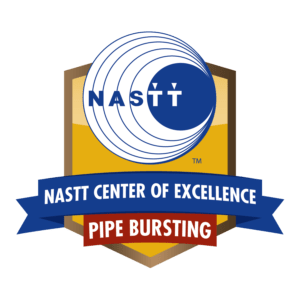 The North American Society for Trenchless Technology has sent out a request for proposals for Professional Engineering Services to update and revise NASTT’s Pipe Bursting Good Practices Training Course.
The North American Society for Trenchless Technology has sent out a request for proposals for Professional Engineering Services to update and revise NASTT’s Pipe Bursting Good Practices Training Course.
RFP Issue Date: Monday, February 25, 2019
RFP Closing Date: 4:00 PM EST – Friday, March 15, 2019
All inquiries to the RFP must be submitted by email only to:
Mr. Michael J. Willmets
NASTT Executive Director
Email: mwillmets@nastt.org
Industry News, trenchless projects
 The No-Dig Down Under Team is seeking abstract submissions for The No-Dig Down Under Conference and Exhibition to be held in Melbourne, Victoria on 10-13 September 2019.
The No-Dig Down Under Team is seeking abstract submissions for The No-Dig Down Under Conference and Exhibition to be held in Melbourne, Victoria on 10-13 September 2019.
Do not miss out on this opportunity to contribute to the 2019 conference program. Please ensure your papers are submitted by Thursday 28 February.
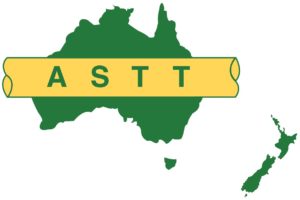 Submissions must be made in electronic format using the online portal; it should outline in 200 words or less the aims, contents and conclusions of the paper, this does not include the title and author details.
Submissions must be made in electronic format using the online portal; it should outline in 200 words or less the aims, contents and conclusions of the paper, this does not include the title and author details.
The categories for submissions are as follows:
- Condition assessment
- Pipe rehabilitation (including pressure pipes)
- Design
- Cured-in-place pipe (CIPP)
- Spiral wound pipe
- Sliplining
- Spray lining
- Pipe bursting
- Grouting
- Installing new pipeline
- Horizontal directional drilling (HDD)
- Microtunnelling
- Pipe jacking
- Pipe ramming
- Manholes, shafts and pits
- Bedding soil grouting/stabilisation
- Direct pipe
- Utility location
- Training
The Technical Committee will be assessing submissions against the following criteria:
- relevant to the theme of the conference, ‘Engaging beneath the surface’,
- relevant to current issues/challenges,
- presents new content or a fresh look at a specific topic,
- relevant to those working in the industry,
- content engages the audience, and has a clear benefit for delegates.
For further information and to submit an abstract please visit www.nodigdownunder.com.
 In April 2019, a Robbins 3.5 m (11.5 ft) diameter Main Beam TBM broke through into open space, completing its 2.8 km (1.7 mi) long tunnel. It was not the first time the machine had encountered open space: twice during tunneling, the machine hit uncharted caverns, the largest of which measured a staggering 8,000 cubic meters (283,000 cubic ft) in size.
In April 2019, a Robbins 3.5 m (11.5 ft) diameter Main Beam TBM broke through into open space, completing its 2.8 km (1.7 mi) long tunnel. It was not the first time the machine had encountered open space: twice during tunneling, the machine hit uncharted caverns, the largest of which measured a staggering 8,000 cubic meters (283,000 cubic ft) in size. The first cavern, while the largest, was not the most difficult void encountered. The machine was averaging 20 to 22 m (65 to 72 ft) advance per day in two shifts after clearing the first cavity, with a dedicated night shift for maintenance. While excavating, a combination of probe drilling and geotechnical BEAM investigation—a type of electricity-induced polarization to detect anomalies ahead of the TBM—were used. Crews ran the excavation five days per week, achieving over 400 m (1,310 ft) in one month. This performance continued until the 2,157 m (7,077 ft) mark, when the machine grazed the top of an unknown cavity that extended deep below the tunnel path. The structure measured 22 m (72 ft) long, 15 m (49 ft) wide, and 14 m (46 ft) deep, or about 4,500 cubic meters (159,000 cubic ft) of open space.
The first cavern, while the largest, was not the most difficult void encountered. The machine was averaging 20 to 22 m (65 to 72 ft) advance per day in two shifts after clearing the first cavity, with a dedicated night shift for maintenance. While excavating, a combination of probe drilling and geotechnical BEAM investigation—a type of electricity-induced polarization to detect anomalies ahead of the TBM—were used. Crews ran the excavation five days per week, achieving over 400 m (1,310 ft) in one month. This performance continued until the 2,157 m (7,077 ft) mark, when the machine grazed the top of an unknown cavity that extended deep below the tunnel path. The structure measured 22 m (72 ft) long, 15 m (49 ft) wide, and 14 m (46 ft) deep, or about 4,500 cubic meters (159,000 cubic ft) of open space. “The cooperation with Marc and his team on site was very good and we always enjoyed their professionalism and commitment to the project and the task. This, without any doubt was key for the success we achieved,” said Detlef Jordan, Business Manager Robbins Europe. “For us, it was satisfying and motivating to see that, by working together and joining the efforts of all partners on the project, the best and most successful outcome can be achieved. This commitment for decades has been at the heart of success in the tunneling industry, but it has not always been observed on other recent projects.”
“The cooperation with Marc and his team on site was very good and we always enjoyed their professionalism and commitment to the project and the task. This, without any doubt was key for the success we achieved,” said Detlef Jordan, Business Manager Robbins Europe. “For us, it was satisfying and motivating to see that, by working together and joining the efforts of all partners on the project, the best and most successful outcome can be achieved. This commitment for decades has been at the heart of success in the tunneling industry, but it has not always been observed on other recent projects.” Galerie des Janots is one of fourteen operations designed to save water and protect resources, which are being carried out by the Aix-Marseille-Provence metropolis, the water agency Rhône Mediterranean Corsica, and the State Government. The Janots gallery, once online, will replace existing pipelines currently located in a railway tunnel—these original pipes have significant deficiencies with estimated water losses of 500,000 cubic meters (132 million gallons) per year. The new tunnel will increase capacity to 440 liters (116 gallons) per second.
Galerie des Janots is one of fourteen operations designed to save water and protect resources, which are being carried out by the Aix-Marseille-Provence metropolis, the water agency Rhône Mediterranean Corsica, and the State Government. The Janots gallery, once online, will replace existing pipelines currently located in a railway tunnel—these original pipes have significant deficiencies with estimated water losses of 500,000 cubic meters (132 million gallons) per year. The new tunnel will increase capacity to 440 liters (116 gallons) per second.








